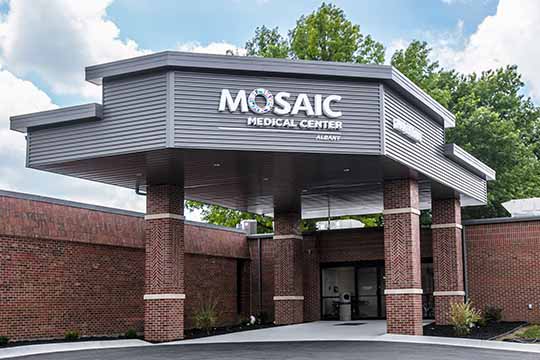At Mosaic Life Care, we understand the importance of offering quality rehabilitation services to our patients. A physical therapy rehabilitation program is specifically designed for each individual depending on the injury, disorder or illness. Our highly-trained and experienced physical therapists in St. Joseph take a multidisciplinary team approach for care and service as the basis of rehabilitation treatment. Multidisciplinary refers to the fact that many different disciplines work together toward a common goal.
In addition to treatment of a wide range of musculoskeletal injuries we also offer the following specialized services:
- Lymphedema
- Women’s health
- Pediatrics
- Myofascial
- Chiropractic
- Dry Needling
Dry Needling Available in St. Joseph, Maryville and Albany
Dry needling is emerging as a popular technique for alleviating musculoskeletal pain and improving movement impairments. The dry needling practice involves the insertion of thin monofilament needles into specific points in the body targeting trigger points, muscles, ligaments, tendons and neurovascular bundles. Unlike acupuncture, dry needling does not aim to manipulate energy flow but instead focuses on neuromusculoskeletal issues.
What is dry needling and how does it work?
Dry needling uses sterile needles without medication or injectate. The needles are inserted into areas of muscular tension or dysfunction commonly referred to as trigger points. These trigger points are knots or irritable spots within a muscle that can cause pain and restricted movement.
The small needles are used to stimulate trigger points, which leads to muscle relaxation, improved blood flow and pain relief.
Dry needling can also aide with tissue restructuring as well as activating the body’s own natural opioids to help with pain relief.
While dry needling uses the same needles as acupuncture, the two are not the same.
"Acupuncture is based more on Chinese medicine," says Doug Lenners, a physical therapist at Outpatient Therapy in St. Joseph. "In dry needling, the needles are placed in the problem areas, directly into the muscle belly that is causing the limitations."
Conditions treated
Dry needling may help relieve pain and increase range of motion. It targets muscle tightness, trigger points and imbalances to alleviate pain and improve mobility.
Some injuries that dry needling is used for include back and shoulder pain, joint pain like knee arthritis and neurological conditions like headaches, migraines and carpal tunnel syndrome.
Frequency and duration of treatment
The frequency of dry needling treatment varies depending on the individual and their specific condition. Typically, patients may undergo treatment once or twice a week with each session lasting 15 – 20 minutes.
Dry needling is often used in conjunction with other physical therapy interventions to provide a compressive care approach. Some patients may experience immediate relief after one dry needling session, while others may require multiple sessions.
Side effects and safety
Although dry needling is generally considered safe, some side effects may occur, including drowsiness, fainting and bruising. Most patients don’t feel the insertion of the needle.
"When the needle is initially inserted, people typically feel a little pinch," says Doug. "If a bad trigger point in the muscle is hit, it may suddenly contract but then will quickly release."
Dry needling offers a promising approach to managing musculoskeletal pain and improving movement impairments.
Almost Like Walking in Space – AlterG Anti–Gravity Treadmill
According to physical therapist Hannah Ferguson, the AlterG is a welcomed addition to the hospital’s Outpatient Therapy department. “We are so excited to offer our patients this unique and cutting-edge technology for improved walking, balance, strengthening and running. The AlterG allows us to take off some of the pressure in the joints in their legs, just like being in a pool, and allows them to move more with less pain. This is an opportunity to enhance their physical therapy experience and allow them to achieve greater goals for their health.”
Patients can use the Anti-Gravity Treadmill to recover from injury and surgery because it allows them to immediately do partial weight-bearing exercises. Patients with neurological disorders maintain, and in some cases, can even regain functionality and mobility working with the AlterG. It is also a wonderful tool to use with patients who are wanting to lose weight, in conjunction with lifestyle and diet change, exercise more with less joint impact and stress.
Benefits to using Anti-Gravity Treadmill technology include unprecedented therapy and training capabilities without the concern of weight-bearing restrictions. The Treadmill controls gravity though air pressure to provide a gentle and comfortable lifting force that reduces a patient’s body weight by as much as 80% so the patient can walk freely and easily.
“This equipment allows us to get patients walking who have to use crutches, canes, or walkers in their everyday routine, enabling our patients to progress though rehab in a safe and effective manner,” says Ferguson. “The impact on the body and the pain of recovery are reduced with the AlterG, which helps people achieve better results.”
Alter-G treadmills can be used for a wide range of injuries and medical conditions, including osteoarthritis, broken bones and muscle strains, multiple sclerosis, strokes, deconditioning, cerebral palsy, weight loss or traumatic brain injury.




